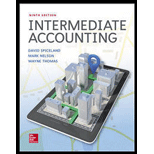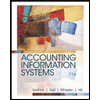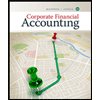
INTERMEDIATE ACCOUNTING (LL) W/CONNECT
9th Edition
ISBN: 9781260679694
Author: SPICELAND
Publisher: MCG
expand_more
expand_more
format_list_bulleted
Concept explainers
Textbook Question
Chapter 3, Problem 3.2BYP
Analysis Case 3–2
Current versus long- term classification
• LO3–2, LO3–3
The usefulness of the
Required:
1. Discuss the factors that determine whether an asset or liability should be classified as current or long-term in a balance sheet.
2. Identify six items that under different circumstances could be classified as either current or long-term. Indicate the factors that would determine the correct classification.
Expert Solution & Answer
Trending nowThis is a popular solution!

Students have asked these similar questions
I need the correct answer to this general accounting problem using the standard accounting approach.
KFC Industries estimates direct labor costs and manufacturing overhead costs for the upcoming year to be $920,000 and $740,000, respectively. KFC allocates overhead costs based on machine hours. The estimated total labor hours and machine hours for the coming year are 23,000 hours and 9,250 hours, respectively. What is the predetermined overhead allocation rate? (Round your answer to the nearest cent.)
Can you help me solve this general accounting question using the correct accounting procedures?
Chapter 3 Solutions
INTERMEDIATE ACCOUNTING (LL) W/CONNECT
Ch. 3 - Prob. 3.1QCh. 3 - Prob. 3.2QCh. 3 - Define current assets and list the typical asset...Ch. 3 - Prob. 3.4QCh. 3 - Prob. 3.5QCh. 3 - Prob. 3.6QCh. 3 - Describe the common characteristics of assets...Ch. 3 - Prob. 3.8QCh. 3 - Prob. 3.9QCh. 3 - Define the terms paid-in-capital and retained...
Ch. 3 - Disclosure notes are an integral part of the...Ch. 3 - A summary of the companys significant accounting...Ch. 3 - Define a subsequent event.Ch. 3 - Prob. 3.14QCh. 3 - Prob. 3.15QCh. 3 - Prob. 3.16QCh. 3 - Prob. 3.17QCh. 3 - Show the calculation of the following solvency...Ch. 3 - Prob. 3.19QCh. 3 - Prob. 3.20QCh. 3 - (Based on Appendix 3) Segment reporting...Ch. 3 - Prob. 3.22QCh. 3 - Prob. 3.23QCh. 3 - Current versus long-term classification LO32,...Ch. 3 - Balance sheet classification LO32, LO33 The trial...Ch. 3 - Prob. 3.3BECh. 3 - Balance sheet classification LO32, LO33 Refer to...Ch. 3 - Balance sheet classification LO32, LO33 The...Ch. 3 - Balance sheet classification LO32, LO33 You have...Ch. 3 - Balance sheet preparation; missing elements LO32,...Ch. 3 - Financial statement disclosures LO34 For each of...Ch. 3 - Calculating ratios LO38 Refer to the trial...Ch. 3 - Prob. 3.10BECh. 3 - Calculating ratios; solving for unknowns LO38 The...Ch. 3 - Balance sheet; missing elements LO32, LO33, LO38...Ch. 3 - Balance sheet classification LO32, LO33 The...Ch. 3 - Balance sheet classification LO32, LO33 The...Ch. 3 - Balance sheet preparation LO32, LO33 The...Ch. 3 - Balance sheet preparation LO32, LO33 The...Ch. 3 - Balance sheet; Current versus long-term...Ch. 3 - Prob. 3.7ECh. 3 - Prob. 3.8ECh. 3 - Balance sheet preparation LO32, LO33 The...Ch. 3 - Financial statement disclosures LO34 The...Ch. 3 - Prob. 3.11ECh. 3 - Prob. 3.12ECh. 3 - Prob. 3.13ECh. 3 - FASB codification research LO32, LO34 Access the...Ch. 3 - Prob. 3.15ECh. 3 - Prob. 3.16ECh. 3 - Prob. 3.17ECh. 3 - Calculating ratios; solve for unknowns LO38 The...Ch. 3 - Prob. 3.19ECh. 3 - Effect of management decisions on ratios LO38...Ch. 3 - Prob. 3.21ECh. 3 - Prob. 3.22ECh. 3 - Balance sheet preparation LO32, LO33 Presented...Ch. 3 - Balance sheet preparation; missing elements LO32,...Ch. 3 - Balance sheet preparation LO32, LO33 The...Ch. 3 - Balance sheet preparation LO32, LO33 The...Ch. 3 - Balance sheet preparation LO32, LO33 The...Ch. 3 - Prob. 3.6PCh. 3 - Balance sheet preparation; errors LO32, LO33 The...Ch. 3 - Balance sheet; errors; missing amounts LO32, LO33...Ch. 3 - Balance sheet preparation LO32 , LO33 Presented...Ch. 3 - Prob. 3.10PCh. 3 - Communication Case 31 Current versus long-term...Ch. 3 - Analysis Case 32 Current versus long- term...Ch. 3 - Prob. 3.4BYPCh. 3 - Judgment Case 35 Balance sheet; errors LO32...Ch. 3 - Prob. 3.6BYPCh. 3 - Real World Case 37 Balance sheet and significant...Ch. 3 - Judgment Case 38 Post fiscal year-end e vents ...Ch. 3 - Prob. 3.9BYPCh. 3 - Prob. 3.10BYPCh. 3 - Prob. 3.11BYPCh. 3 - Analysis Case 314 Balance sheet information LO32...Ch. 3 - Prob. 3.15BYPCh. 3 - Ethics Case 316 Segment reporting Appendix 3 You...Ch. 3 - Prob. 1CCTC
Knowledge Booster
Learn more about
Need a deep-dive on the concept behind this application? Look no further. Learn more about this topic, accounting and related others by exploring similar questions and additional content below.Similar questions
- Can you solve this general accounting problem with appropriate steps and explanations?arrow_forwardCan you solve this financial accounting question with accurate accounting calculations?arrow_forwardI am looking for a reliable way to solve this financial accounting problem using accurate principles.arrow_forward
- I am searching for the accurate solution to this general accounting problem with the right approach.arrow_forwardPlease provide the accurate answer to this general accounting problem using valid techniques.arrow_forwardPlease show me the correct approach to solving this financial accounting question with proper techniques.arrow_forward
arrow_back_ios
SEE MORE QUESTIONS
arrow_forward_ios
Recommended textbooks for you
 Financial & Managerial AccountingAccountingISBN:9781285866307Author:Carl Warren, James M. Reeve, Jonathan DuchacPublisher:Cengage Learning
Financial & Managerial AccountingAccountingISBN:9781285866307Author:Carl Warren, James M. Reeve, Jonathan DuchacPublisher:Cengage Learning AccountingAccountingISBN:9781337272094Author:WARREN, Carl S., Reeve, James M., Duchac, Jonathan E.Publisher:Cengage Learning,
AccountingAccountingISBN:9781337272094Author:WARREN, Carl S., Reeve, James M., Duchac, Jonathan E.Publisher:Cengage Learning, Auditing: A Risk Based-Approach to Conducting a Q...AccountingISBN:9781305080577Author:Karla M Johnstone, Audrey A. Gramling, Larry E. RittenbergPublisher:South-Western College Pub
Auditing: A Risk Based-Approach to Conducting a Q...AccountingISBN:9781305080577Author:Karla M Johnstone, Audrey A. Gramling, Larry E. RittenbergPublisher:South-Western College Pub Accounting Information SystemsFinanceISBN:9781337552127Author:Ulric J. Gelinas, Richard B. Dull, Patrick Wheeler, Mary Callahan HillPublisher:Cengage Learning
Accounting Information SystemsFinanceISBN:9781337552127Author:Ulric J. Gelinas, Richard B. Dull, Patrick Wheeler, Mary Callahan HillPublisher:Cengage Learning Corporate Financial AccountingAccountingISBN:9781305653535Author:Carl Warren, James M. Reeve, Jonathan DuchacPublisher:Cengage Learning
Corporate Financial AccountingAccountingISBN:9781305653535Author:Carl Warren, James M. Reeve, Jonathan DuchacPublisher:Cengage Learning Corporate Financial AccountingAccountingISBN:9781337398169Author:Carl Warren, Jeff JonesPublisher:Cengage Learning
Corporate Financial AccountingAccountingISBN:9781337398169Author:Carl Warren, Jeff JonesPublisher:Cengage Learning

Financial & Managerial Accounting
Accounting
ISBN:9781285866307
Author:Carl Warren, James M. Reeve, Jonathan Duchac
Publisher:Cengage Learning

Accounting
Accounting
ISBN:9781337272094
Author:WARREN, Carl S., Reeve, James M., Duchac, Jonathan E.
Publisher:Cengage Learning,

Auditing: A Risk Based-Approach to Conducting a Q...
Accounting
ISBN:9781305080577
Author:Karla M Johnstone, Audrey A. Gramling, Larry E. Rittenberg
Publisher:South-Western College Pub

Accounting Information Systems
Finance
ISBN:9781337552127
Author:Ulric J. Gelinas, Richard B. Dull, Patrick Wheeler, Mary Callahan Hill
Publisher:Cengage Learning

Corporate Financial Accounting
Accounting
ISBN:9781305653535
Author:Carl Warren, James M. Reeve, Jonathan Duchac
Publisher:Cengage Learning

Corporate Financial Accounting
Accounting
ISBN:9781337398169
Author:Carl Warren, Jeff Jones
Publisher:Cengage Learning
ACCOUNTING BASICS: Debits and Credits Explained; Author: Accounting Stuff;https://www.youtube.com/watch?v=VhwZ9t2b3Zk;License: Standard Youtube License